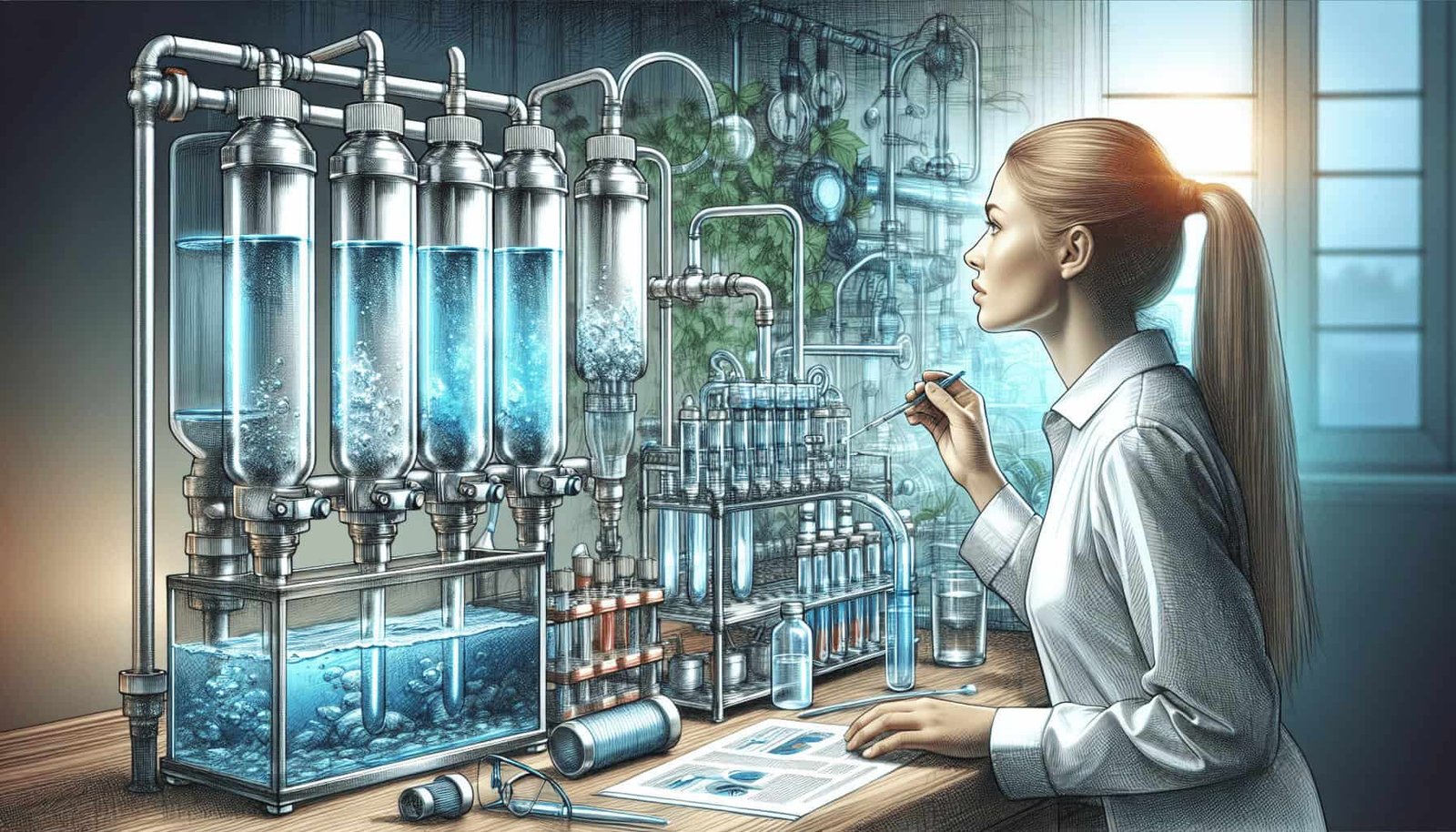Have you ever wondered how to effectively treat well water that is contaminated with high levels of technetium-99? In this article, we will explore various treatment methods that have proven to be effective in addressing this issue. Whether you are a homeowner relying on well water for your everyday needs or a professional in the field, this information will provide valuable insights into tackling the challenge of technetium-99 contamination in well water.

Reverse Osmosis
Overview of Reverse Osmosis
Reverse osmosis is a highly effective treatment method for well water with high levels of Technetium-99 (Tc-99). It is a process that uses a semi-permeable membrane to remove contaminants from water, including Tc-99. This method is known for its high removal efficiency and is widely used for water purification purposes.
How Reverse Osmosis Works
In reverse osmosis, water is pushed through a semipermeable membrane under high pressure. This membrane allows water molecules to pass through while blocking the larger molecules and ions, including Tc-99. The pressure applied forces the water to move from higher solute concentration (the well water) to lower solute concentration (the treated water), effectively removing Tc-99 and other contaminants.
Removal Efficiency of Technetium-99
Reverse osmosis has a high removal efficiency for Technetium-99, typically achieving a reduction of up to 99% or more. This makes it an excellent choice for treating well water with high levels of Tc-99, ensuring the water is safe for consumption.
Pre-treatment Requirements
Before the water can undergo reverse osmosis treatment, some pre-treatment processes may be necessary. These may include the removal of larger particles and sediments through filtration or the adjustment of pH levels to optimize the efficiency of the reverse osmosis system. Pre-treatment requirements may vary depending on the specific characteristics of the well water.
Maintenance and Cost Considerations
Maintenance requirements for reverse osmosis systems are generally minimal. Regular filter replacements and routine system checks are recommended to ensure optimal performance. The cost of a reverse osmosis system can vary depending on factors such as the capacity, brand, and additional features. However, it is considered a cost-effective solution in the long run, given its high removal efficiency and durability.
Ion Exchange
Overview of Ion Exchange
Ion exchange is another effective method for removing Technetium-99 from well water. It involves the exchange of ions, primarily replacing unwanted ions in the water with more desirable ions. This process is commonly used for water softening and can be employed to remove Tc-99 and other contaminants.
How Ion Exchange Works
Ion exchange relies on a resin bed, which is made up of tiny resin beads containing ion groups. As the water flows through the resin bed, the ions in the water are exchanged with the ions attached to the resin beads. The resin beads with the attached target ions, such as Tc-99, are then removed from the system, leaving behind purified water.
Removal Efficiency of Technetium-99
Ion exchange has a high removal efficiency for Technetium-99, often achieving reductions of over 90%. This makes it a reliable method for treating well water with elevated Tc-99 levels.
Pre-treatment Requirements
Pre-treatment requirements for ion exchange systems may involve the removal of larger particles and sediments through filtration. Adjustment of the water’s pH levels may also be necessary to optimize the ion exchange process and enhance its efficiency.
Maintenance and Regeneration
Maintenance of ion exchange systems involves periodic regeneration of the resin bed. This process involves rinsing the bed with a saline solution or an acid solution to recharge the resin beads and remove any accumulated Tc-99 ions. The frequency of regeneration may vary depending on the specific system and water quality.
Cost Considerations
The cost of ion exchange systems can vary depending on factors such as capacity, brand, and additional features. Additionally, the cost of regenerating the resin bed should be considered. However, ion exchange is recognized as a cost-effective treatment method, considering its removal efficiency and longevity.
Activated Carbon Filtration
Overview of Activated Carbon Filtration
Activated carbon filtration is a commonly used treatment method for removing organic contaminants, including Technetium-99, from well water. It utilizes activated carbon, which has a large surface area and adsorptive properties, to trap and remove contaminants.
How Activated Carbon Filtration Works
In activated carbon filtration, water passes through a bed of activated carbon that acts as a filter. As the water flows through the carbon, organic contaminants, such as Tc-99, are trapped on the surface of the carbon through a process called adsorption. This physical and chemical bonding effectively removes the contaminants from the water.
Removal Efficiency of Technetium-99
Activated carbon filtration has a moderate to high removal efficiency for Technetium-99, typically achieving reductions of up to 90% or more. While it may not be as efficient as reverse osmosis or ion exchange, it is still a viable option for treating well water with elevated Tc-99 levels.
Pre-treatment Requirements
Prior to activated carbon filtration, pre-treatment processes such as sediment filtration or adjustment of pH levels may be necessary to optimize the system’s performance. These pre-treatment requirements depend on the specific characteristics of the well water being treated.
Maintenance and Replacement
Maintenance of activated carbon filtration systems involves regular replacement of the carbon filter media. The frequency of replacements depends on factors such as water quality and usage. It is important to monitor the filter’s effectiveness and replace it when it becomes saturated to maintain efficient contaminant removal.
Cost Considerations
The cost of activated carbon filtration systems can vary depending on factors such as capacity, brand, and the need for additional pre-treatment processes. Additionally, the cost of replacing the carbon filter media should be considered. However, in general, activated carbon filtration is a cost-effective treatment method, especially for well water contaminated with organic compounds like Technetium-99.
Electrocoagulation
Overview of Electrocoagulation
Electrocoagulation is an innovative treatment method that utilizes an electric current to facilitate the removal of contaminants from water, including Technetium-99. This process involves the generation of metal hydroxide flocs that encapsulate the contaminants, allowing for their separation from the water.
How Electrocoagulation Works
In electrocoagulation, an electric current is passed through an electrode, typically made of materials like aluminum or iron. This results in the formation of metal hydroxide flocs, which act as a coagulant. These flocs then bind with the contaminants, including Tc-99, forming larger particles that can be easily separated from the water.
Removal Efficiency of Technetium-99
Electrocoagulation has shown promising results for the removal of Technetium-99 from water sources, achieving removal efficiencies of up to 99% or more. This makes it a highly effective method for treating well water with high Tc-99 levels.
Pre-treatment Requirements
Pre-treatment requirements for electrocoagulation systems may involve the removal of larger particles and sediments through filtration. pH adjustment may also be necessary to optimize the coagulation process. These pre-treatment processes aid in improving the overall efficiency and treatment performance of electrocoagulation systems.
Maintenance and Operation
Maintenance of electrocoagulation systems typically involves removing the separated flocs and periodically cleaning or replacing the electrodes. Monitoring the system’s performance and adjusting parameters such as current density and treatment time is also important to ensure optimal operation.
Cost Considerations
The cost of electrocoagulation systems may vary depending on factors such as capacity, electrode materials, and additional pre-treatment requirements. However, electrocoagulation is often considered a cost-effective treatment method due to its high removal efficiency and potential for automation.

Oxidation
Overview of Oxidation Methods
Oxidation methods are effective for treating well water with high levels of Technetium-99. This treatment approach involves the use of chemical oxidants or advanced oxidation processes (AOPs) to convert Tc-99 and other contaminants into less harmful forms.
Chemical Oxidation
Chemical oxidation utilizes strong oxidants, such as chlorine or ozone, to oxidize contaminants in the water. This process chemically alters the structure of Tc-99, rendering it less mobile and easier to remove. Chemical oxidation can be an effective treatment method for well water contaminated with Tc-99.
Advanced Oxidation Processes (AOPs)
Advanced oxidation processes involve the combination of different oxidation methods, such as the use of UV light with hydrogen peroxide or ozone. These processes generate highly reactive hydroxyl radicals that can break down complex organic compounds, including Technetium-99. AOPs can be particularly effective for treating well water with high levels of Tc-99.
Removal Efficiency of Technetium-99
Oxidation methods, whether chemical or advanced, have shown high removal efficiencies for Technetium-99. Reductions of up to 99% or more can be achieved, making oxidation a viable treatment method for well water contaminated with Tc-99.
Pre-treatment Requirements
Pre-treatment requirements for oxidation methods may involve the removal of particulates and sediments through filtration. Adjustment of pH levels may also be necessary to optimize the oxidation process. These pre-treatment processes help improve the overall effectiveness of oxidation in removing Tc-99.
Maintenance and Operation
Maintenance of oxidation systems generally involves monitoring the oxidant levels, ensuring proper dosing, and maintaining the condition of the equipment. Routine inspections and maintenance checks are recommended to ensure the oxidation process operates efficiently.
Cost Considerations
The cost of oxidation systems can vary depending on factors such as the specific oxidant used, the required dosing equipment, and the system’s capacity. Additionally, the ongoing cost of oxidant supply or replacement should be considered. However, oxidation methods are generally cost-effective, given their high removal efficiency and versatility in treating various contaminants.
Bioremediation
Overview of Bioremediation
Bioremediation is an environmentally friendly treatment method that employs living organisms to degrade or transform contaminants, including Technetium-99, into less toxic forms. It utilizes the natural abilities of microorganisms to break down and remove pollutants from water.
Bioremediation Approaches for Technetium-99
Bioremediation approaches for Technetium-99 mainly involve microbial processes. Various microorganisms, such as bacteria or fungi, can be used to efficiently remove or transform Tc-99. These microorganisms interact with Tc-99, converting it into less mobile and less toxic forms.
Removal Efficiency of Technetium-99
Bioremediation has shown significant potential for the removal of Technetium-99 from water sources. Reduction efficiencies of up to 90% or more have been achieved using specific microbial processes. While the removal efficiency may vary depending on the specific technique and environmental factors, bioremediation offers a promising approach for treating well water contaminated with Tc-99.
Pre-treatment Requirements
Pre-treatment requirements for bioremediation systems may involve the removal of larger particles and sediments through filtration. Adjusting the water’s pH and temperature to accommodate the growth and activity of the specific microorganisms used is also important for optimizing performance.
Maintenance and Monitoring
Maintenance of bioremediation systems primarily involves monitoring the microbial populations and their activity, as well as ensuring favorable environmental conditions for their growth. Regular monitoring and potential adjustments are crucial to maintain effective Tc-99 removal.
Cost Considerations
The cost of bioremediation systems can vary depending on factors such as the specific techniques and microorganisms employed, as well as the scale of the system. Furthermore, ongoing monitoring and potential nutrient supplementation may add to the overall cost. However, bioremediation offers a sustainable and cost-effective treatment method for well water with high levels of Tc-99, considering its potential for long-term contaminant removal.

Nanofiltration
Overview of Nanofiltration
Nanofiltration is a membrane filtration process that effectively removes various contaminants, including Technetium-99, from well water. It operates on a smaller pore size range than reverse osmosis, allowing for the removal of divalent ions and partial removal of monovalent ions.
How Nanofiltration Works
In nanofiltration, water is forced through a semipermeable membrane with nanopores. These nanopores are smaller than those used in microfiltration and ultrafiltration, but larger than those used in reverse osmosis. This allows for the selective removal of specific ions and contaminants, including Tc-99, based on their size and charge.
Removal Efficiency of Technetium-99
Nanofiltration has shown substantial removal efficiency for Technetium-99, typically achieving reductions of up to 99% or more. The combination of size exclusion and charge-based interactions enables effective removal of Tc-99 from well water.
Pre-treatment Requirements
Pre-treatment requirements for nanofiltration systems generally involve the removal of larger particles and sediments through filtration. Adjustment of pH and the removal of oxidants or disinfectants may also be necessary to prevent membrane fouling and optimize the performance of the nanofiltration process.
Maintenance and Cleaning
Maintenance of nanofiltration systems involves periodic cleaning of the membrane to remove any accumulated fouling or scale. The cleaning frequency and procedure may vary depending on factors such as water quality and operating conditions.
Cost Considerations
The cost of nanofiltration systems can vary depending on factors such as the capacity, brand, and additional pre-treatment requirements. Additionally, the costs associated with membrane cleaning and replacement should be considered. Nevertheless, nanofiltration is generally regarded as a cost-effective treatment method, given its high removal efficiency and versatility in removing various contaminants, including Technetium-99.
Ultrafiltration
Overview of Ultrafiltration
Ultrafiltration is a membrane filtration process that effectively removes particles, colloids, bacteria, and larger molecules from well water, including Technetium-99. It operates on a larger pore size range than nanofiltration and reverse osmosis, making it suitable for retaining larger contaminants.
How Ultrafiltration Works
In ultrafiltration, water is forced through a semipermeable membrane that has larger pores compared to nanofiltration and reverse osmosis membranes. This allows for the physical sieving of contaminants, preventing their passage and effectively removing them from the water.
Removal Efficiency of Technetium-99
Ultrafiltration has shown moderate to high removal efficiency for Technetium-99, achieving reductions of up to 90% or more. While it may not be as efficient as some other treatment methods, ultrafiltration is still capable of effectively reducing Tc-99 levels in well water.
Pre-treatment Requirements
Pre-treatment requirements for ultrafiltration systems typically involve the removal of larger particles, sediments, and other solids through pre-filtration. This helps to protect the ultrafiltration membrane and enhance its overall performance.
Maintenance and Cleaning
Maintenance of ultrafiltration systems requires periodic cleaning of the membrane to remove any accumulated fouling or blockage. The cleaning frequency and procedure may vary depending on water quality, environmental conditions, and operating parameters.
Cost Considerations
The cost of ultrafiltration systems can vary depending on factors such as the specific membrane type, capacity, and pre-treatment requirements. Additionally, the cost of membrane cleaning and potential replacement should be considered. However, ultrafiltration is generally considered a cost-effective treatment method, given its effective removal of various contaminants, including Technetium-99.

Membrane Filtration
Overview of Membrane Filtration
Membrane filtration is a versatile treatment method that employs different types of membranes for the removal of various contaminants, including Technetium-99. It involves the use of semi-permeable membranes that allow water molecules to pass through while retaining undesirable substances.
Types of Membrane Filtration
There are different types of membrane filtration, each catering to specific filtration needs and target contaminants. These include reverse osmosis, nanofiltration, ultrafiltration, and microfiltration. Each type operates on varying pore sizes, allowing for the removal of different-sized particles and ions.
Removal Efficiency of Technetium-99
The removal efficiency of Technetium-99 through membrane filtration depends on the specific type of membrane used. Reverse osmosis and nanofiltration, with their smaller pore sizes, typically achieve higher removal efficiencies of up to 99% or more. Ultrafiltration and microfiltration can also achieve significant reductions in Tc-99 levels, albeit to a slightly lesser extent.
Pre-treatment Requirements
Pre-treatment requirements for membrane filtration systems may involve the removal of larger particles and sediments through pre-filtration. In some cases, adjustments to pH levels or the removal of certain contaminants may be necessary to prevent membrane fouling and optimize filtration performance.
Maintenance and Cleaning
Maintenance of membrane filtration systems typically involves regular cleaning or replacement of the membranes, depending on their fouling or scaling condition. Monitoring the membrane condition and conducting routine inspections are essential to ensure efficient treatment and prolong the lifespan of the membranes.
Cost Considerations
The cost of membrane filtration systems can vary depending on factors such as the specific membrane type, capacity, and maintenance requirements. Additionally, the ongoing cost of membrane cleaning or replacement should be considered. However, membrane filtration is generally considered a cost-effective treatment method due to its versatility, high removal efficiencies, and potential for long-term use.
Combination Treatment Methods
Benefits of Combination Treatment Methods
Combination treatment methods, also known as treatment trains, involve the sequential or parallel application of multiple treatment processes to achieve optimal removal of contaminants, including Technetium-99. These treatment trains offer several benefits, including improved removal efficiency, greater adaptability to different water qualities, and enhanced treatment performance.
Example Treatment Train
An example treatment train for well water with high levels of Technetium-99 may involve initial pre-filtration to remove larger particles and sediments, followed by a combination of reverse osmosis and activated carbon filtration. This combination provides effective removal of Tc-99 and enhances overall treatment efficiency.
Removal Efficiency of Technetium-99
Combination treatment methods can significantly enhance the removal efficiency of Technetium-99. By integrating multiple treatment processes, each with its unique mechanisms of contaminant removal, overall reduction efficiencies of up to 99% or more can be achieved, ensuring well water safety.
Pre-treatment, Maintenance, and Cost Considerations
Pre-treatment requirements for combination treatment methods may involve a range of processes, including filtration, pH adjustment, and disinfection. Maintenance requirements may encompass regular monitoring, inspection, and potential replacement of filtration media or membranes. The cost considerations for combination treatment methods may vary depending on the specific processes implemented, the required capacity, and maintenance needs. However, the benefits of increased removal efficiency and improved treatment performance make combination treatment methods a valuable and cost-effective solution for well water with high Technetium-99 levels.
In conclusion, various treatment methods are effective for well water with high levels of Technetium-99. Reverse osmosis, ion exchange, activated carbon filtration, electrocoagulation, oxidation, bioremediation, nanofiltration, ultrafiltration, and membrane filtration offer different approaches to remove Tc-99, each with its advantages and considerations. By understanding the overview, working principles, removal efficiency, pre-treatment requirements, maintenance, and cost considerations of these treatment methods, you can make an informed decision and choose the most suitable method for your specific well water treatment needs.

